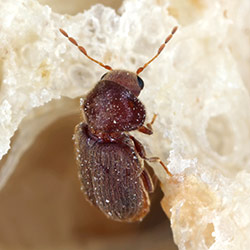Identification
- Colour Brown or reddish-brown
- Size Up to 3.5 mm long
- Also known as Biscuit beetles
- Description Cylindrical, with a pair of three-segmented club antennae and deep pits on the wing covers, which give the insect a grooved appearance.
- Notes Their larvae are cream-coloured grubs, shaped like the letter C.

What do drugstore beetles look like
Cylindrical in shape, the drugstore beetle is sometimes confused with the closely related and similar-looking cigarette beetle. While both types of beetles appear solid brown or reddish-brown in colour, certain distinguishing characteristics help separate the two species. The drugstore beetle possesses a pair of three-segmented club antennae and deep pits on the wing covers, which give the insect a striated appearance. Drugstore beetles also possess fine hairs running lengthwise along the wing covers. The stored-food pest measures up to 3.5 mm in length.
Habitat, Diet, Lifecycle/Reproduction
Habitat
Although they prefer to live in warmer environments outdoors, drugstore beetles can survive just about anywhere heated shelter is available. Various commercial sites provide ideal conditions for the pests, including cereal and pet food manufacturing facilities, storage warehouses, and flour mills. The drugstore beetle is an expert flier and attracted to light, making home invasions both possible and likely.
Diet
Drugstore beetles eat a variety of different foods. While they cause the most damage to stored grains, seeds, and flour, the insects maintain a diverse and relatively indiscriminate diet that also includes pet foods, spices, books and manuscripts, leather, wool, hair, and even drugs, hence their common name. Known to even bore through wooden objects, the pests are capable of penetrating through tin, aluminium foil, and lead sheets, making stored foods virtually unprotected.
Life Cycle/Reproduction
Female drugstore beetles lay as many as 100 eggs or more at a time. The eggs are pearl white and difficult to see. They are deposited in a suitable food source and typically hatch after about 10 days. The newly hatched larvae are cream-coloured grubs shaped like the letter “C” and measure around 5 mm in length. After pupating for 12 to 18 days, immature drugstore beetles emerge as adults. The typical lifespan of an adult drugstore beetle ranges from 14 to 65 days.
Why do I have drugstore beetles
Commercial sites like cereal and pet food manufacturing facilities provide ideal conditions for drugstore beetles looking for warmth and food. They are also commonly found in flour mills, bakeries, confectioners, distribution centres, food warehouses, retail stores, and homes.
These pests are expert fliers, attracted to both light and a variety of food sources, like grains, seeds, flour, pet foods, spices, books and manuscripts, leather, wool, hair, and even drugs.
Female drugstore beetles can lay more than 100 eggs at a time, usually depositing them in a suitable food source on which the larvae can feed when they hatch after 10 days.
How worried should I be about drugstore beetles
An infestation of drugstore beetles at a food manufacturing or distribution facilities can be devastating for business owners, ruining their reputation, causing huge financial losses, and impacting their ability to even operate.
The excrement these beetles leave behind can irritate the mouth, throat, and stomach if ingested. Foods infested by drugstore beetles are not fit for consumption and cannot be sold.
Drugstore beetles can even bore through wood, as well as inorganic materials, like tin, aluminium foil, and lead sheets, making stored food products virtually unprotected.
For museum owners, a drugstore beetle infestation can be equally serious, as drugstore beetles can chew through books, paper, animal horns and antlers. They can damage or destroy displayed and stored artifacts and, in extreme instances, priceless museum pieces.
In the home, these beetles damage stored and post-harvest grains and seeds, as well as packaged food products. These contaminated foods are unsafe to eat and must be discarded.
Whether drugstore beetles have attacked your business or home, home remedies can be dangerous. To effectively eradicate a drugstore beetle infestation and prevent harm to your business, your home, or your family, you need a professional pest control service.
How can I prevent drugstore beetles invading
Do not store exposed foods on shelves or in pantries, Store foods in glass containers with tight-fitting lids, Clean and vacuum shelves, bins, and storage areas, Rotate food stock and do not mix old and new products, Keep food storage areas dry and clean. When food items show signs of infestation, heating small quantities at a time in an oven may successfully eliminate the insects. However, this method of drugstore beetle removal proves less than sanitary and may still render the infested food inedible. The selective use of appropriately labelled insecticides can be used to manage and control drugstore beetle infestations. For extreme cases of drugstore beetle infestations, contacting a professional pest control specialist is often the best course of action to take.
Other pests related to Drugstore Beetles
100% Satisfaction or Money Back Guarantee
Resolving your pest problem is our #1 priority. If re-treatment is required, we'll provide immediate services at no extra cost. If your expectations are not met, we guarantee a full refund of your service payment.
Remove pests from your home, and stop them from coming back
We work hard to listen, understand and assess your unique situation. Request a free, no-obligation estimate today for a customized pest program that fits your needs.
Request a Free Home EstimateRequest a Free Business Consultation

